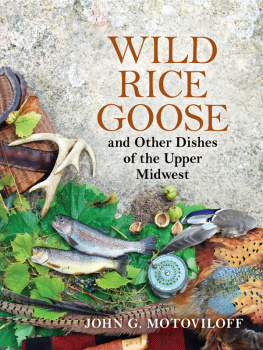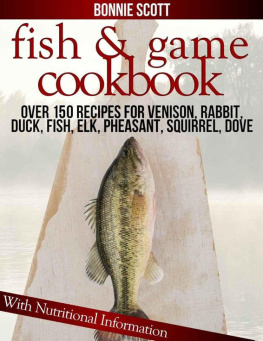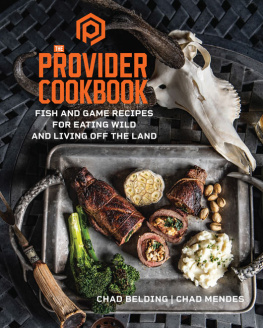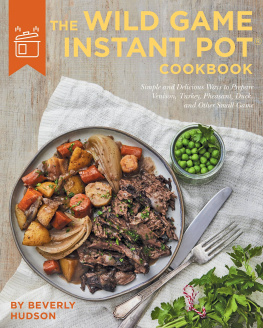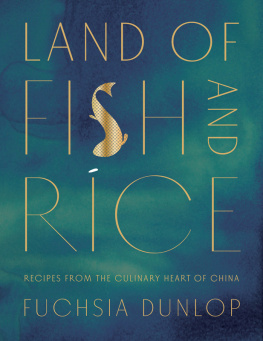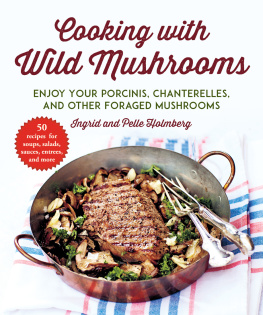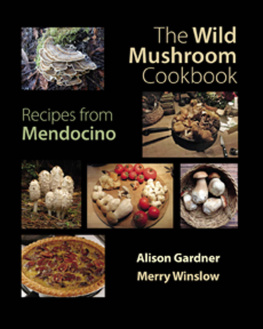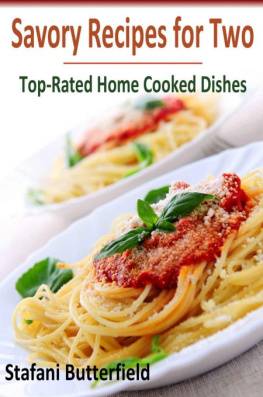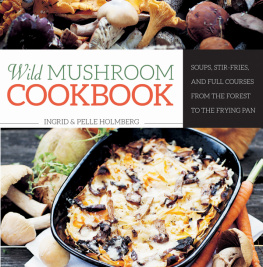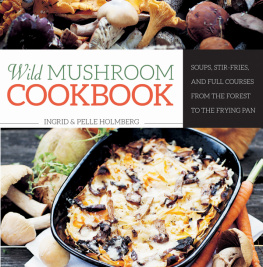WILD RICE GOOSE
and Other Dishes
of the Upper Midwest
John G. Motoviloff
The University of Wisconsin Press
The University of Wisconsin Press
1930 Monroe Street, 3rd Floor
Madison, Wisconsin 53711-2059
uwpress.wisc.edu
3 Henrietta Street
London WC2E 8LU, England
eurospanbookstore.com
Copyright 2014
The Board of Regents of the University of Wisconsin System
All rights reserved. No part of this publication may be reproduced, stored in a retrieval system, or transmitted, in any format or by any means, digital, electronic, mechanical, photocopying, recording, or otherwise, or conveyed via the Internet or a website without written permission of the University of Wisconsin Press, except in the case of brief quotations embedded in critical articles and reviews.
Printed in the United States of America
Library of Congress Cataloging-in-Publication Data
Motoviloff, John, 1967, author.
Wild rice goose and other dishes of the Upper Midwest / John G. Motoviloff.
pages cm
Includes index.
ISBN 978-0-299-29904-0 (pbk. : alk. paper) ISBN 978-0-299-29903-3 (e-book)
1. Cooking (Game) 2. Cooking (Fish) 3. Cooking (Wild foods) 4. Cooking, AmericanMidwestern style. 5. CookingMiddle West. I. Title.
TX751.M68 2014
641.5977dc23
2013033114
Cover photo and design: Sara DeHaan
Book design: Caroline Beckett, Flying Fish Graphics
Theres no taking of trout with dry breeches.
Cervantes
CONTENTS
PREFACE
I hope you will find this book useful, maybe even fun. In it, Ive included the best of my fish and game recipes plus a few tips and tidbits here and there. Hunters, anglers, and foragers will learn new ways to cook their catchand revisit some old favorites. Ive kept the approach and recipes simple. This means beginners wont be overwhelmed by details, and seasoned kitchen hands can improvise: use shallots instead of garlic, for instance, or port instead of wine, a pinch of a favorite spice. This book is also meant for those who like wild-foods but dont get out to harvest them. Perhaps a neighbor or relative drops by with a brace of mallards, bag of morel mushrooms, panfish fillets, or a venison roastnow youll know exactly what to do. And for those who prefer to get their wildfoods by making a trip to the store, clicking a mouse, or calling on the telephone, Ive provided a list of fish, game, and wildfood vendors.
I said that I included my best fish and game recipes. This is true. But just as you need many hands to build a house, you need a bunch of outdoors friends to write a fish and game cookbook. These are the guys who go out with you to field and stream and beyondfollowing bird dogs through thigh-deep snow, standing in lakes that are freezing up, dragging deer out of the brambles with a tractor, hunting squirrel behind the farm, stalking spring creeks for wild trout, or hauling a canoe into the Wisconsin River. Im lucky to count as compadres Steve Miller, Sam Diman, Dan OBrien, Robert Pallitto, Bradley Czachor, Erik Seeman, Craig Amacker, Clarene Ditsch, and Canisius Johnson.
On the home front, my wife, Kerry Motoviloff, and daughter, Anne Motoviloff, kept things running smoothly so I could go out on wild goose chases. They were also the tasting crew, praising me when deserved and telling me to start again when I missed the mark.
Lots of other folks helped with recipes and cooking tips. Thanks to Denny Weiss and Bill Kalishek of the Iowa DNR; Pat Rivers of the Minnesota DNR; George Wilkes of the Angry Trout Caf in Grand Marais, Minnesota; Mike Valley of Valley Fish and Cheese in Prairie du Chien, Wisconsin; and the Peterson family of Hancock, Michigan. Dan OIve got to thank you here again! To the Johnson clan of Soldiers Grove, Wisconsin, many thanks for a home away from home.
Raphael Kadushin, Matthew Crosby, Adam Mehring, Scott Lenz, and other University of Wisconsin Press staff members provided invaluable insight, guidance, and help. Thanks to the Presss reviewers for thoughtful feedback that helped make this a better book.
To Kathryn Motoviloff, Ellen Miller, and my late grandparents Michael and Anna Motoviloff, I owe a great debt of gratitude for instilling in me a love of Slavic food and culture. Thanks also to the rest of my family, who provided ample encouragement. If Ive forgotten anyone, its only because so many have helped.
I NTRODUCTION
W hether pushing through swaths of prairie grass with a pair of bird dogs, jigging for whitefish on frozen Green Bay, or rumbling along sandy Northwoods roads in search of a secret berry patch, the Upper Midwest presents todays hunter-gatherer with a wide range of wildfoods and an array of landscapes in which to pursue them. This book is your guide to making the most of these treasurers. Staples for generations of Native Americans and then for the European settlers who came after them, these foods continue to provide healthy, local eating. Whats more, many of these delicacies can now be purchased in person or online from a variety of vendorsfrom MacFarlane Pheasant Farm in southern Wisconsin to commercial fishermen on Lake Superior and a host of farmers markets and specialty vendors in between.
Big game populations in our region remain strong. Whitetail deer are abundant. Black bear populations are holding stable. Wild pig populations have sprung up in some Midwest states. Thanks to careful Department of Natural Resources management of herds and a lottery system for licenses, Michigan hunters have the opportunity to hunt elk and Minnesota hunters have the opportunity to hunt moose.
Gamebird populations are, for the most part, alive and well. North American duck populations are well above the fifty-year average. Good goose and dove flightsand locally abundant pheasant and grousesweeten the wingshooters pot. Wild turkeys have been reintroduced in much of the Upper Midwest; their numbers are strong and their range expanding northward. If woodcock, quail, and sharptail grouse numbers are spottier, this is offset by the abundance of other birds. Whether its rich fruit-roasted duck or ruffed grouse cooked gently with forest mushrooms, Northern Tier wingshooters have plenty of birds to pursuenot to mention rabbit, snowshoe hare, and squirrel.
The culinary and sporting rewards of fish are no less thrilling. These can be familiar favorites, such as walleye taken right from the live basket to the cottage stovetop, trout from a cold spring creek poached to perfection, or fat panfish from a reedy lake fried up in a black skillet. There are also long-forgotten classics such as snapping turtle soup and upcoming foods such as whitefish caviarhighly sought after in coastal and European restaurants. Spread it on some black bread and youll understand what all the fuss is about. Well learn how to bread up and deep fry a batch of smelt, and to serve up rough fish like sheepshead or carp so your friends will think theyre eating prime gamefish.
If it appears I have neglected wild plants, perhaps Im saving the best for last. If you wonder whether foraging is alive and well in the twenty-firstcentury Northern Tier, go to a rural caf or tavern on a warm May morning. The conversation will be, Finding any little grays? which is shorthand for Are the first morel mushrooms up? A few weeks later and its off to the fencerows and ditches to hunt wild asparagus. This is followed by a profusion of wild berries: strawberries, blackcaps, gooseberries, blackberries. And then its on to the time of nuts, wild rice, and forest mushrooms.

